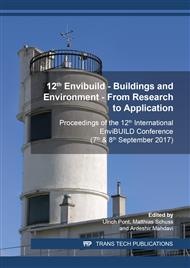[1]
A.J. Lewy, T.A. Wehr, F.K. Goodwin, D.A. Newsome, S.P. Markey, Light suppresses melatonin secretion in humans, Science, 210 (1980) 1267-1269.
DOI: 10.1126/science.7434030
Google Scholar
[2]
A. Carrillo-Vico, P.J. Lardone, N. Alvarez-Sanchez, A. Rodriguez-Rodriguez, J.M. Guerrero, Melatonin: buffering the immune system, International journal of molecular sciences, 14 (2013) 8638-8683.
DOI: 10.3390/ijms14048638
Google Scholar
[3]
R. Hardeland, Melatonin and the theories of aging: a critical appraisal of melatonin's role in antiaging mechanisms, Journal of pineal research, 55 (2013) 325-356.
DOI: 10.1111/jpi.12090
Google Scholar
[4]
J.R. Calvo, C. Gonzalez-Yanes, M.D. Maldonado, The role of melatonin in the cells of the innate immunity: a review, Journal of pineal research, 55 (2013) 103-120.
DOI: 10.1111/jpi.12075
Google Scholar
[5]
G.C. Brainard, J.P. Hanifin, M.D. Rollag, J. Greeson, B. Byrne, G. Glickman, E. Gerner, B. Sanford, Human melatonin regulation is not mediated by the three cone photopic visual system, The Journal of clinical endocrinology and metabolism, 86 (2001) 433-436.
DOI: 10.1210/jcem.86.1.7277
Google Scholar
[6]
K. Thapan, J. Arendt, D.J. Skene, An action spectrum for melatonin suppression: evidence for a novel non-rod, non-cone photoreceptor system in humans, The Journal of physiology, 535 (2001) 261-267.
DOI: 10.1111/j.1469-7793.2001.t01-1-00261.x
Google Scholar
[7]
M. Karasek, K. Winczyk, Melatonin in humans, Journal of physiology and pharmacology: an official journal of the Polish Physiological Society, 57 Suppl 5 (2006) 19-39.
Google Scholar
[8]
R.J. Hughes, R.L. Sack, A.J. Lewy, The role of melatonin and circadian phase in age-related sleep-maintenance insomnia: assessment in a clinical trial of melatonin replacement, Sleep, 21 (1998) 52-69.
DOI: 10.1093/sleep/21.1.52
Google Scholar
[9]
J.L. Anderson, C.A. Glod, J. Dai, Y. Cao, S.W. Lockley, Lux vs. wavelength in light treatment of Seasonal Affective Disorder, Acta Psychiatr Scand, 120 (2009) 203-212.
DOI: 10.1111/j.1600-0447.2009.01345.x
Google Scholar
[10]
R.G. Stevens, Y. Zhu, Electric light, particularly at night, disrupts human circadian rhythmicity: is that a problem?, Philos T R Soc B, 370 (2015).
DOI: 10.1098/rstb.2014.0120
Google Scholar
[11]
D.B. Boivin, P. Boudreau, Impacts of shift work on sleep and circadian rhythms, Pathologie-biologie, 62 (2014) 292-301.
DOI: 10.1016/j.patbio.2014.08.001
Google Scholar
[12]
M. Terman, J.S. Terman, Light therapy for seasonal and nonseasonal depression: efficacy, protocol, safety, and side effects, CNS spectrums, 10 (2005) 647-663; quiz 672.
DOI: 10.1017/s1092852900019611
Google Scholar
[13]
M. Andersen, J. Mardaljevic, S.W. Lockley, A framework for predicting the non-visual effects of daylight - Part I: photobiology-based model, Lighting research & technology, 44 (2012) 37-53.
DOI: 10.1177/1477153511435961
Google Scholar
[14]
B. Wood, M.S. Rea, B. Plitnick, M.G. Figueiro, Light level and duration of exposure determine the impact of self-luminous tablets on melatonin suppression, Applied ergonomics, 44 (2013) 237-240.
DOI: 10.1016/j.apergo.2012.07.008
Google Scholar
[15]
M. Rea, M. Figueiro, Light as a circadian stimulus for architectural lighting, Lighting research & technology, 0 (2016) 1-14.
DOI: 10.1177/1477153516682368
Google Scholar
[16]
DIN V 5031-100 Strahlungsphysik im optischen Bereich und Lichttechnik – Teil 100: Über das Auge vermittelte, melanopische Wirkung des Lichts auf den Menschen – Größen, Formelzeichen und Wirkungsspektren. August (2016).
DOI: 10.31030/2334694
Google Scholar


